
(Photo from Huffington Post UK)
A few days ago, this sequence of camera trap images of a giant panda (Ailuropoda melanoleuca) gnawing on the carcass of an animal started showing up on news sites all over the world. It's received quite a fair bit of attention, and certainly reveals a darker side to the seemingly placid and peaceful nature of the giant panda. However, it does appear that much of the coverage of this story overlooks a couple of facts.
For one thing, much of the reaction to this has been that of surprise, when it's actually been known for decades that while giant pandas feed predominantly on bamboo, they will consume meat on rare occasions. Still, as far as I know, this is the first time a giant panda has been caught on camera actually eating meat, with the images publicised to the western world (more on that later).
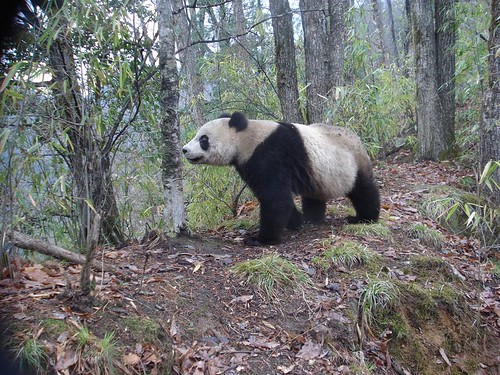
Wild giant panda photographed by camera trap;
(Photo by Smithsonian Wild)
In the past, giant pandas have been witnessed catching small rodents such as Chinese bamboo rats (Rhizomys sinensis). In the late 1980s, when conservationist George Schaller and his team were attempting to capture giant pandas so that they could be fitted with radio collars, domestic pig bones and goat heads were used to lure the bears into the traps. The hair of golden snub-nosed monkey (Rhinopithecus roxellana) and the bones and hair of alpine musk deer (Moschus chrysogaster) have also been found in the droppings of wild giant pandas.

Golden snub-nosed monkey;
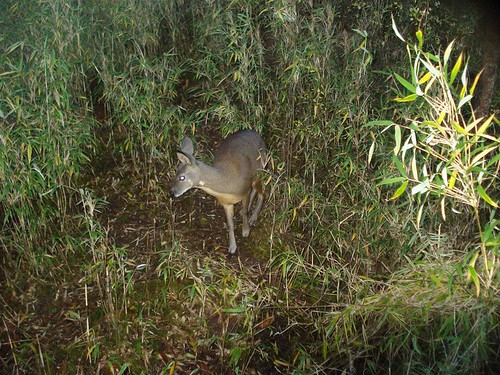
Forest musk deer (Moschus berezovskii);
(Photos by Smithsonian Wild)
Here are some older records of giant pandas revealing their carnivorous ancestry (Click to enlarge).

(Table from Giant Pandas: Biology and Conservation)
Whether these cases involved active predation or scavenging is not revealed, but I won't be surprised if in some cases, a giant panda will deliberately kill and eat a small and easy target. After all, earlier last year, a giant panda in the Wuhan Zoo chased down and killed a peacock (Pavo cristatus) in its enclosure.

(Photo from The Telegraph)
(As an aside, this reminds me a lot of another recent clash between a giant panda and a peacock)
As for the locals who live in giant panda country, some have seen for themselves what happens when a giant panda develops a taste for domestic livestock. There's also a short documentary segment from a Chinese television show (parts one and two) about a wild animal that began visiting a village to kill domestic goats. After an overly dramatic re-enactment in which a hunting party heads into the forest in an attempt to track down the predator, a trap is set in the village and baited with a live goat. The culprit turns out to be a giant panda, which is subsequently captured and brought into captivity. If only there was an update about this particular individual and its feeding habits!
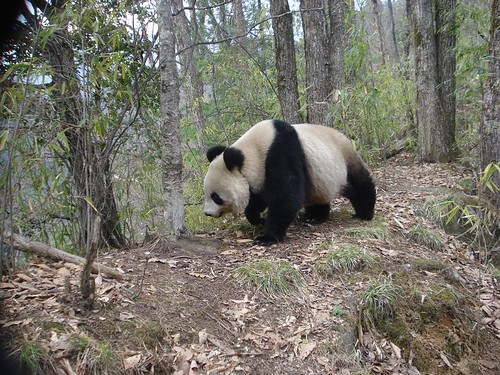
(Photo by Smithsonian Wild)
The giant panda shares its forest habitat with two other species of bears: the Asiatic black bear (Ursus thibetanus) and the Tibetan subspecies of the brown bear (Ursus arctos pruinosus).
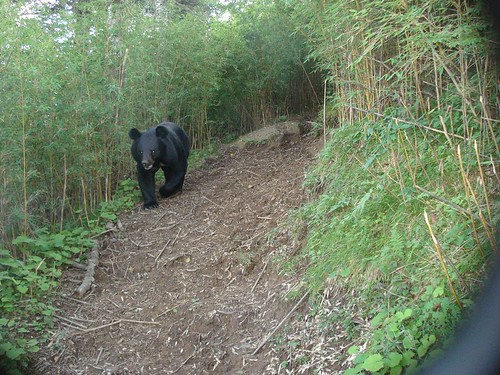
Asiatic black bear;
(Photo by Smithsonian Wild)
One important point to take note of is that meat-eating still occurs very infrequently in giant pandas, and it is not known if giant pandas turn to meat to meet some nutritional requirements, such as when females are pregnant or raising cubs, or when their staple food is harder to obtain, such as during bamboo die-offs. It could be that the few records of giant pandas eating animal matter simply represent chance encounters with carrion or really easy opportunities to pick off vulnerable prey. Perhaps it's all a matter of individual preferences.
Another point of contention has been the identity of the animal being chewed on by the giant panda. Most English news sources state that the giant panda was eating an antelope (Daily Mail, Huffington Post UK) or a gnu/wildebeest (Guardian, MSNBC, NPR, Telegraph, even the BBC).
It's certainly very odd, considering that the two species of wildebeest (also known as gnu) (Connochaetes spp.) are antelopes native to the savannas and grasslands of southern and eastern Africa.

Common wildebeest (Connochaetes taurinus), Tanzania;
(Photo by Tommaso Balestrini)
Certainly not the sort of ungulate you'd see in the mountain forests of Sichuan.
Where did the "gnu" or "wildebeest" identification come from?
Chinese news sources (like Sina.com.cn) state that the giant panda was feeding on the carcass of a 牛羚 ('cow-antelope'), which is one of the Chinese names used for wildebeest, also known as 角马 ('horn-horse').
I'm sure it's probably a case of an error in translation, with the English-language news sites simply accepting the erroneous identification without double-checking if there are actually wildebeest in China.
But if it's not a wildebeest, then what animal was the giant panda feeding on?
It turns out that there is another animal that bears the name of 牛羚, one that definitely shares the same habitat as the giant panda: the takin (Budorcas taxicolor).
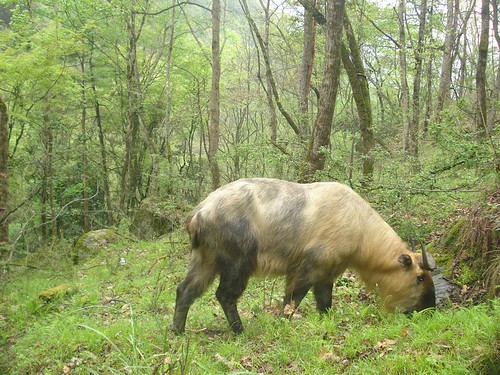

(Photos by Smithsonian Wild)
This large, shaggy herbivore does bear some resemblance to a wildebeest or a cow, although it's actually more closely related to sheep and goats.
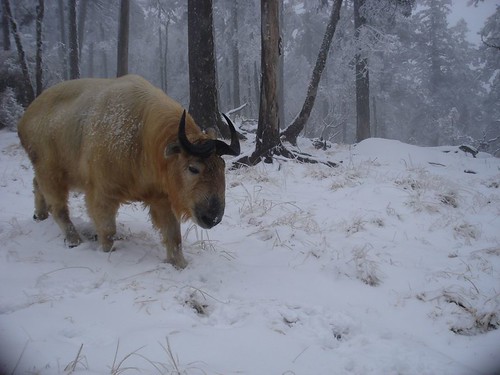

(Photos by Smithsonian Wild)
So that solves the puzzle; no, it wasn't a case of a lost wildebeest, but just an error in translation of the term 牛羚. At the moment, only Cool Green Science, the conservation blog of The Nature Conservancy, correctly states that the giant panda was feeding on a takin. The Nature Conservancy also has a short slideshow with more camera trap images of our meat-eating giant panda.
Apparently, the takin carcass was that of an adult, estimated to weigh more than 100 kilograms. Given their size and reputation for being aggressive, I think it's unlikely that the giant panda managed to hunt and kill a takin. In this case, it was determined that the takin had died from natural causes at least three to four days before the giant panda visited the carcass. It's not mentioned whether the takin was most likely killed by a predator, or had died due to illness, old age, or had simply fallen off a cliff.
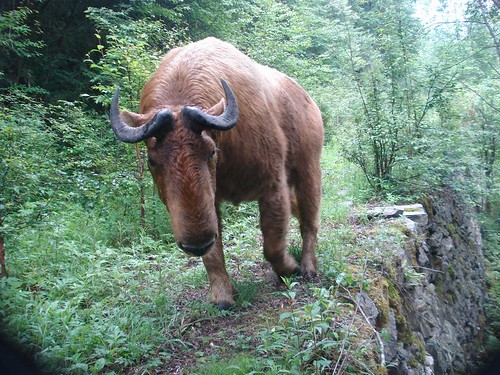
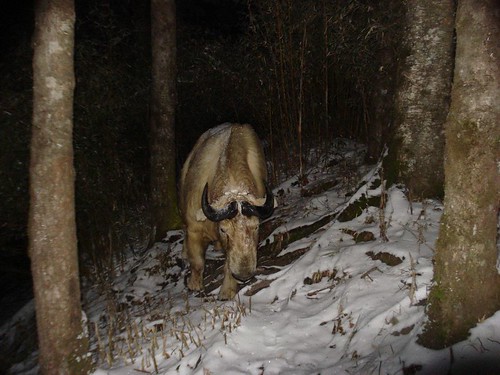
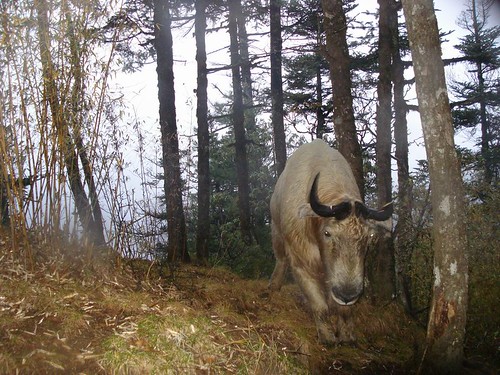
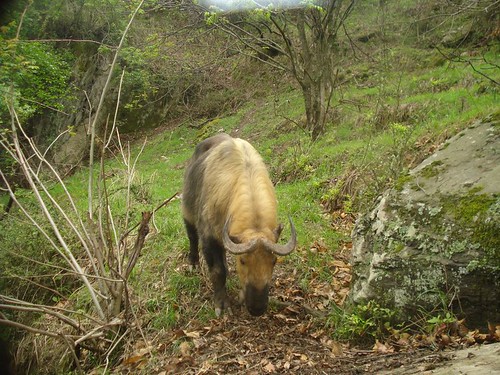
I think you've probably realised by now that the takin is my new favourite obscure animal;
(Photos by Smithsonian Wild)
Now that more people know that giant pandas do consume meat once in a while, there's a lot of potential for further research. Is there variation between giant panda populations with regards to carnivorous habits, and if this is the case, what are the possible factors affecting meat consumption in giant pandas? Are giant pandas more likely to eat meat when bamboo is in short supply, or is it simply innate behaviour that's triggered merely by the easy access to meat, regardless of the abundance of bamboo? Does meat-eating come naturally, or do cubs learn from their mothers? Are pregnant or lactating females more likely to consume meat, given their increased need for nutrients? Do we have 'rogue' giant pandas that abandon their bamboo diet and become serial killers of livestock? How capable are giant pandas at catching live prey, and how similar are they to other bear species in terms of hunting behaviour? How important are large predators such as wolves (Canis lupus) and leopards (Panthera pardus) in providing carcasses for giant pandas to scavenge, and now that these carnivores are vanishing from many forests due to hunting and persecution, how does this affect the availability of carrion for the local giant pandas?
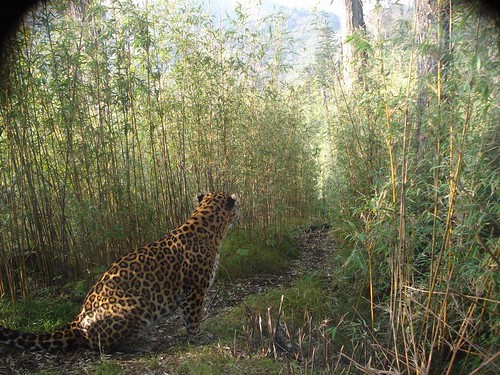
Leopard in Sichuan forest;
(Photo by Smithsonian Wild)
Perhaps the biggest mystery of all is why giant pandas depend so overwhelmingly on bamboo, when they live in forests full of much more nutritious fare, whether it's in the form of berries or meat. Fossil evidence suggests that as long as 2 million years ago, the giant panda's ancient relatives were already evolving to feed on bamboo, although to this day, the giant panda's claws, teeth, and digestive tract still betray its origins as a carnivore, and it remains horribly inefficient at converting already nutrient-poor bamboo into energy. This is why the giant panda spends so much of its time feeding or sleeping, and unlike the Asiatic black bear and brown bear that share its forests, doesn't hibernate at all during the winter - its diet simply doesn't allow it to build up the fat reserves needed for hibernation.
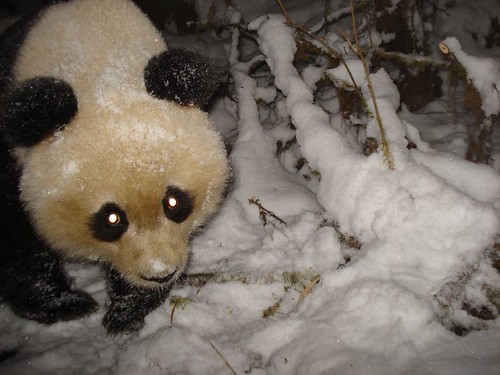
(Photo by Smithsonian Wild)
Bamboo provides a stable and abundant year-round food supply, and is not exploited by many other species, and the giant panda has evolved to fill a very special niche. However, at the same time, it's lost the dietary flexibility that is seen in most other bear species, which are capable of feeding on a wide range of items, both animal and vegetable in origin.
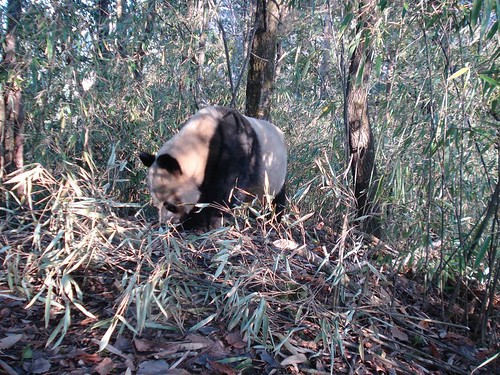
(Photo by Smithsonian Wild)
The giant panda could presumably prosper on a diet similar to that of other bears, though that raises the question of why we don't have more records of giant pandas eating meat, or even other more nutritious plant matter such as berries and bark. Captive giant pandas certainly seem to do alright when foodstuffs other than bamboo are incorporated into their diet, though I wonder if any zoo would ever allow its precious giant pandas to be raised on a diet more suited for say, a brown bear.

Giant panda eating apple, Berlin Zoo;
(Photo by AnthonyGurr)

Salad for the grizzly bear, San Francisco Zoo;
(Photo by wynner3)
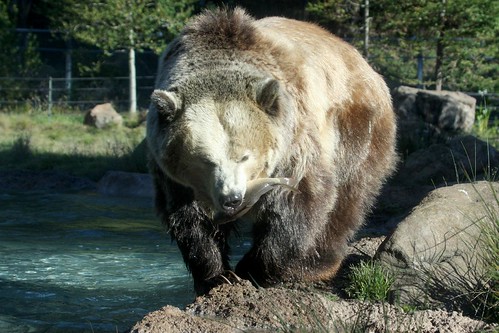
Fish for the grizzly bear, San Francisco Zoo;
(Photo by birdbuddy)
Perhaps, given enough time, giant pandas may become even more specialised for feeding on bamboo, and lose even these occasional cravings for meat. Or there may come a stage, several millenia in the future, where in the face of ecological changes, giant pandas end up returning to a more varied diet akin to that of other bears. Of course, this depends on the continued long-term survival of giant panda populations in the wild. Far from a dead end doomed to go extinct, I like to think of the giant panda as an evolutionary success story, and it is interesting to consider how an animal like the giant panda has evolved to become a vegetarian and managed to survive, despite retaining so much baggage from its carnivorous ancestry.